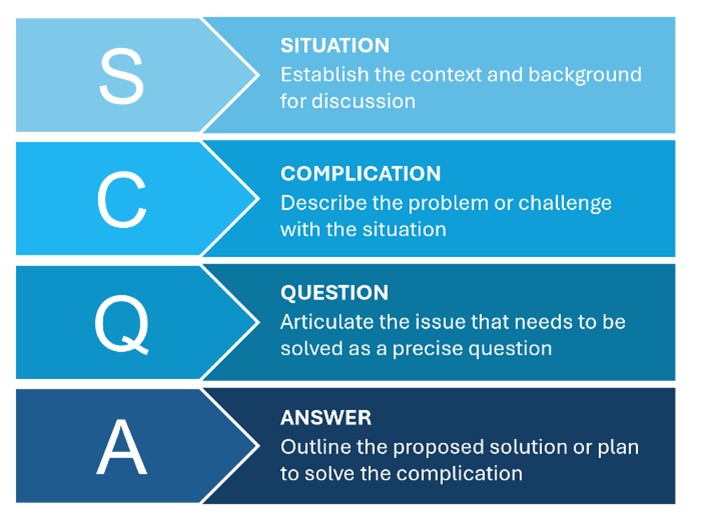Impactful and engaging communication is an integral cornerstone and an essential requirement for any type of learning content. Clear and concise messaging that is delivered in a thoughtful format can significantly influence how the content is perceived, absorbed, retained, and recalled in the future by the learning audience.
While the instructional design discipline offers numerous successful models and strategies to effectively communicate and organize learning concepts for maximum impact (ARCS, Gagne's Nine Events of Instruction, and Merrill's Principles of Instruction readily come to mind), my personal favorite is a communication framework I learned and practiced extensively during my management consulting days as an L&D specialist.
The beauty of this framework lies in its inherent simplicity and its undeniable power to deliver strong and memorable learning experiences through the art of storytelling. More popularly used in business writing—such as proposals, executive presentations, customer pitches, research papers, product descriptions, emails, advertising, and even TL;DR-style communications—I have personally found this framework to be incredibly versatile and applicable to almost any form of communication, including training.
The framework I am talking about is the SCQA Framework.
Introduced by Barbara Minto in her 1981 book, The Pyramid Principle, the SCQA framework was originally created as a way of improving consultancy reports to enable the key points to resonate with senior executives. Since then, the SCQA framework has found applications in business consulting, journalism, policy writing, science, academia, marketing, and more.
In my work, I love to apply this framework to instructional writing and training content organization. Its linear structure is tremendously powerful in grabbing and holding the interest of the learning audience and lends itself very well to how we design and craft our training deliverables.
So let me walk you through what this framework is and how it works.
Understanding the SCQA framework
SCQA is a communication framework that breaks down the key components of discussion into four distinct parts, each of which builds upon the message, resulting in a linear and engaging narrative that follows a logical storytelling format.
The four components of the SCQA framework are as follows:
1: Situation (S)
The Situation component serves as the starting point of the conversation. It aims to establish the known, agreed-upon facts about the topic of discussion. This is where the context is set and the status quo is established. This component helps to make sure that the audience is in alignment on the topic of discussion as well as the background behind it.
If you think of this component in terms of storytelling, this is the initial step where key characters of the story are introduced and their history is established. The key characters here can be actual human beings; tangible objects, such as a product; or non-tangible subjects, such as a process, a practice, a company, a team, a software, or a technology.
Let's understand how to craft the Situation with the help of a rudimentary example:
Customers use the ExpertEduc8 website to subscribe and take courses aimed at advancing their professional skills. Since the subscription process is based on entitlement levels, which can be complex, the website team created a job aid to simplify this process. The goal is to make the subscription process clearer for new and returning customers alike.
2: Complication (C)

The Complication component comes next. It highlights the problems, challenges, or inherent issues with the Situation. This is where the urgency is established and the need for the discussion is uncovered.
As the second step in the flow of storytelling, this component aims to convey the proverbial 'twist' in the storyline. This is where tension is introduced and the real reason for the story is unraveled, as the example shows:
Currently, the subscription job aid is hosted on the company's internal content management system (CMS), which requires users to log in before accessing the job aid. This setup creates a major issue for new ExpertEduc8 customers, who do not have login credentials yet, making it impossible for them to view the job aid before subscribing. As a result, customers who would benefit from understanding the subscription process prior to purchasing cannot access the information they need, leading to confusion, frustration, and an increased number of support calls. The internal CMS also lacks the capability to provide unauthenticated access, meaning that even a simple fix like making the job aid available without logging in is not possible under the current system.
3: Question (Q)
Once the complication has been established, the Question component seeks to ask the question of how the problem or issue can be solved or prevented. This is where the audience is hooked: This critical question centers the discussion; a decision or collective sign-off is needed to move forward.
From a storytelling perspective, this is where the attention of the audience is directed toward the specific challenge that needs to be addressed. It also aims to get audience members' thoughts tuned to thinking about if/how the problem could potentially be solved, thereby putting them in a position where they are ready to hear about the solution. Our sample question accomplishes this:
How can the ExpertEduc8 team ensure that new customers can easily access the job aid on the main page of the website, while navigating the limitations of the internal content management system?
4: Answer (A)
With the Question component having mentally prepared the audience for a natural progression into a solution-focused discussion, the fourth and final component of the SCQA framework—Answer—is perfectly poised to do just that. This component outlines the solution that answers the Question asked in step 3 to solve the Complication described in step 2. The solution presented here could be a direct way of solving the problem, a recommendation or proposal, a plan, or a list of potential options to pursue.
From a storytelling standpoint, this is where we reach the climax and the path forward for the main character of the story becomes clear:
The ExpertEduc8 team recommends collaborating with the company's IT department to create a public-facing folder on the separate digital content library that is managed by IT and that allows public access. By hosting the job aid there, the team can bypass the authentication requirement, allowing anyone to view the job aid directly from the main page of the website.
However, this solution requires the approval of both the ExpertEduc8 operations leadership and the IT leader to proceed, since it involves coordination between teams and changes in how content is managed and accessed. Once approval is granted, this approach will effectively resolve the issue and improve the user experience for new customers trying to subscribe to ExpertEduc8.
Benefits of using the SCQA framework
The SCQA framework breaks down the complex parts of the discussion into a simple and engaging format. It provides a powerful way of organizing information in a clear and compelling way. By arranging parts of the discussion in a naturally progressing flow of thinking, the SCQA framework helps the audience stay focused and centered around the main topic of the discussion.
The storytelling style of the SCQA framework enables the audience's thought process to move along with that of the presenters. It helps the audience transition naturally from the problem to the solution; in doing so, it serves as an excellent form of persuasion.
By helping the audience be mentally poised to hear the answer to the complication, this framework silently nurtures them to be more receptive and open to what comes next. That enables presenters to make their point with more impact and highlight the value of their proposed solution more effectively.
Because of its impactful storytelling format and its ability to articulate concepts with clarity and precision, the SCQA framework is highly beneficial in the field of learning and instructional design. It offers a neat way to help instructional designers create clear, engaging, and problem-focused learning experiences that guide learners through the content in a logical and purposeful manner.
Interested in more?
Download this template to structure your communications using the SCQA framework (note: the template will open in your PDF reader).
To learn how to structure your training content using SCQA, read Neha Divakarla’s follow-up article, Applying the SCQA Framework to Instructional Design.


